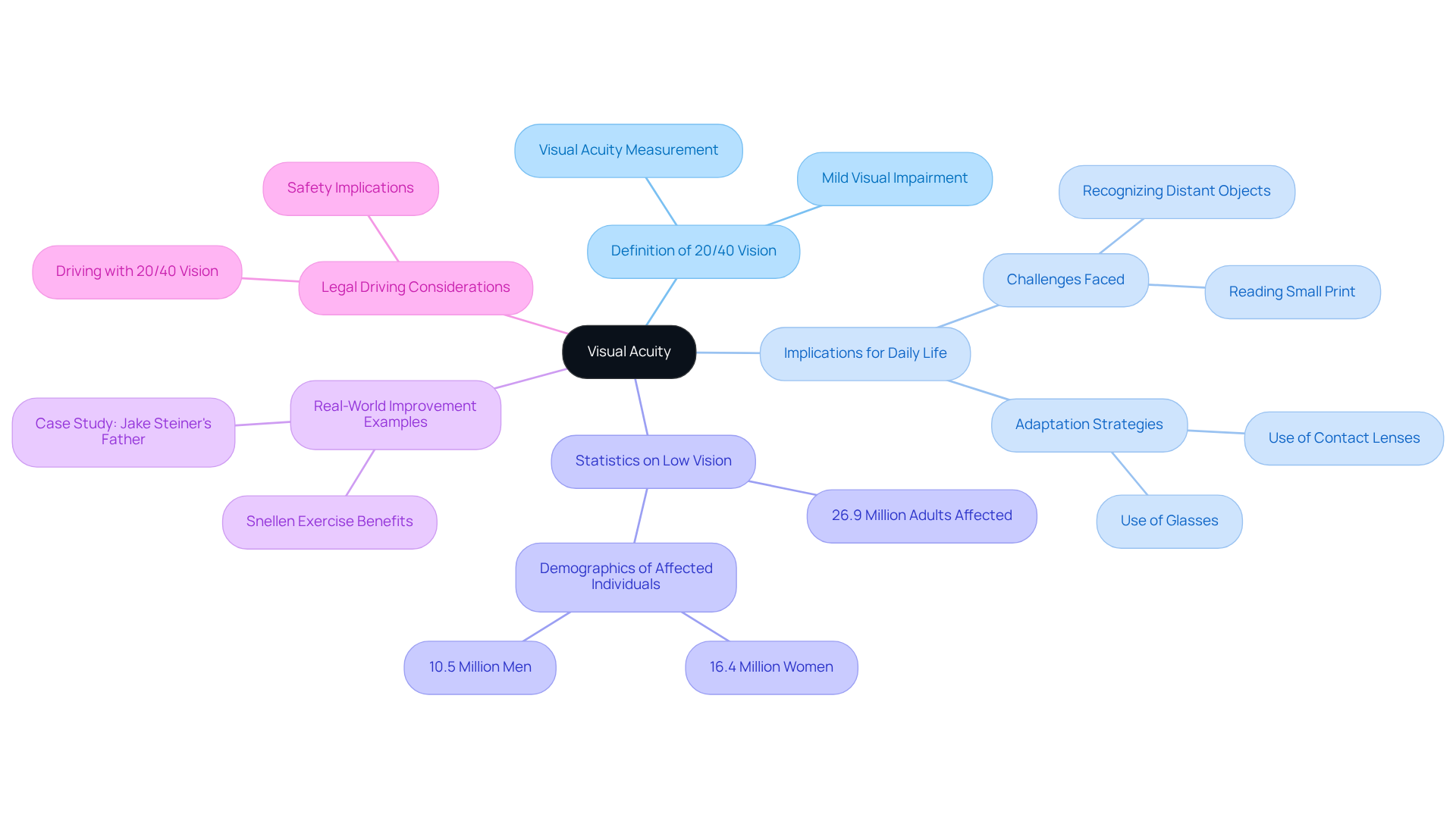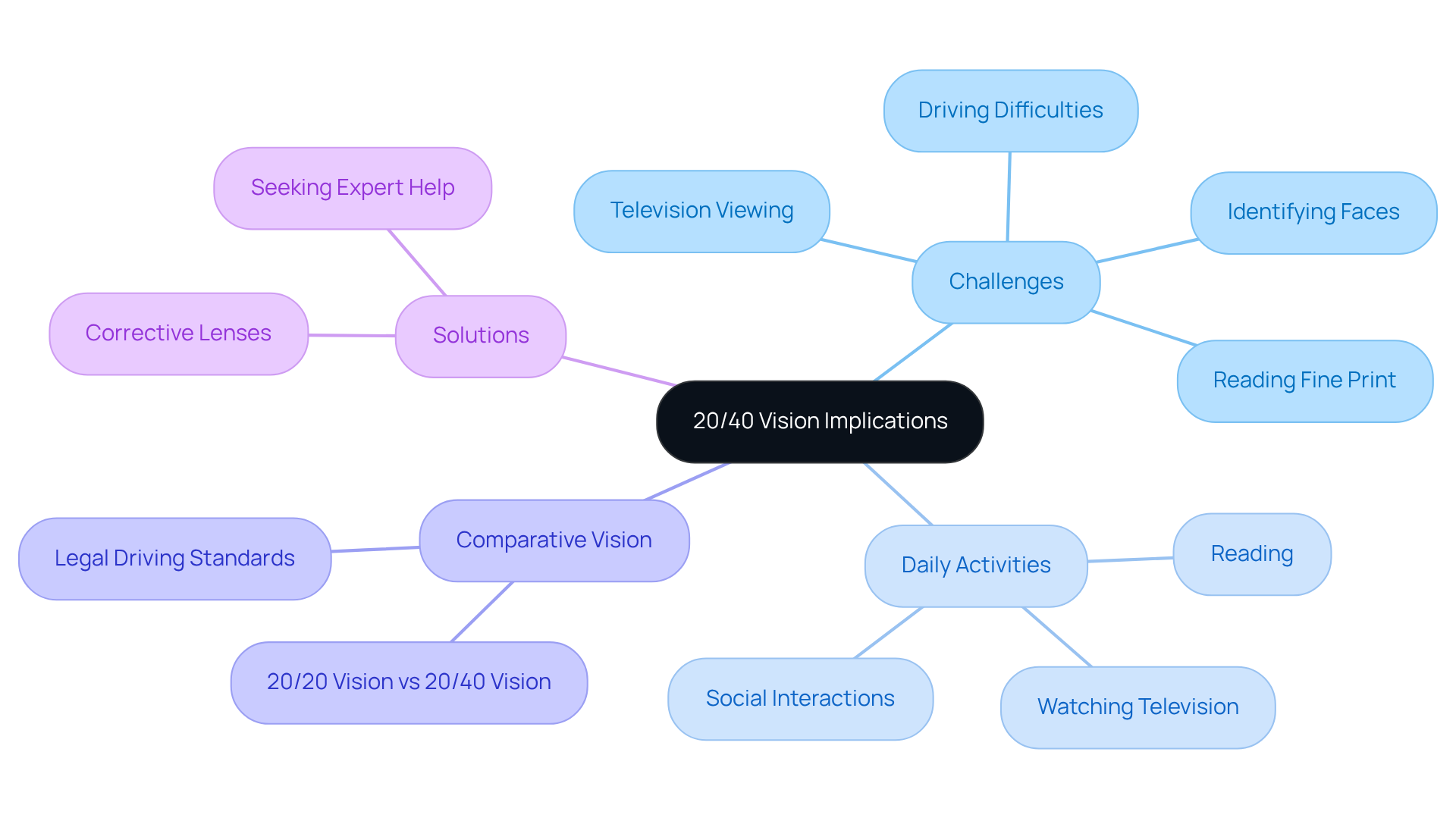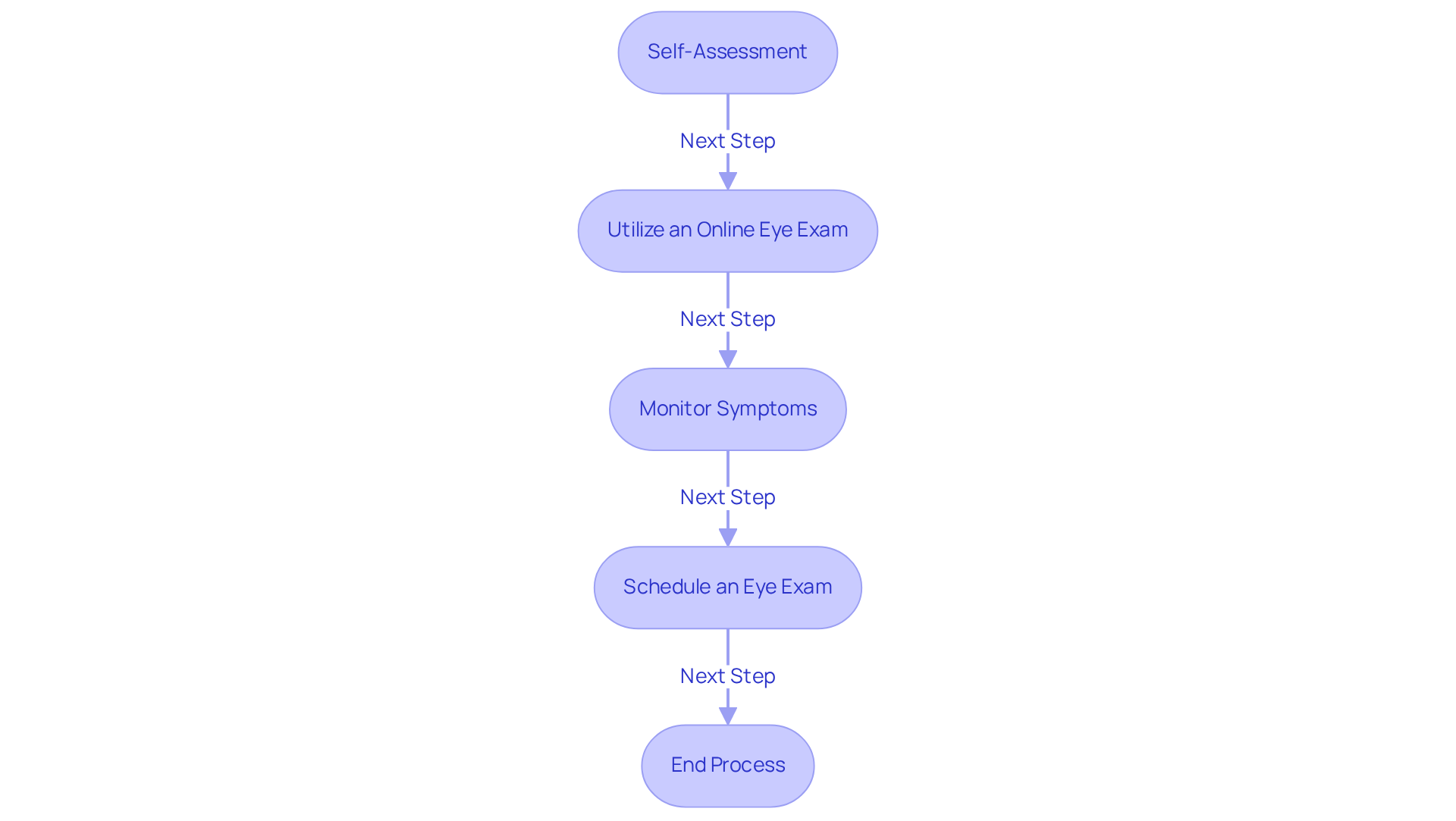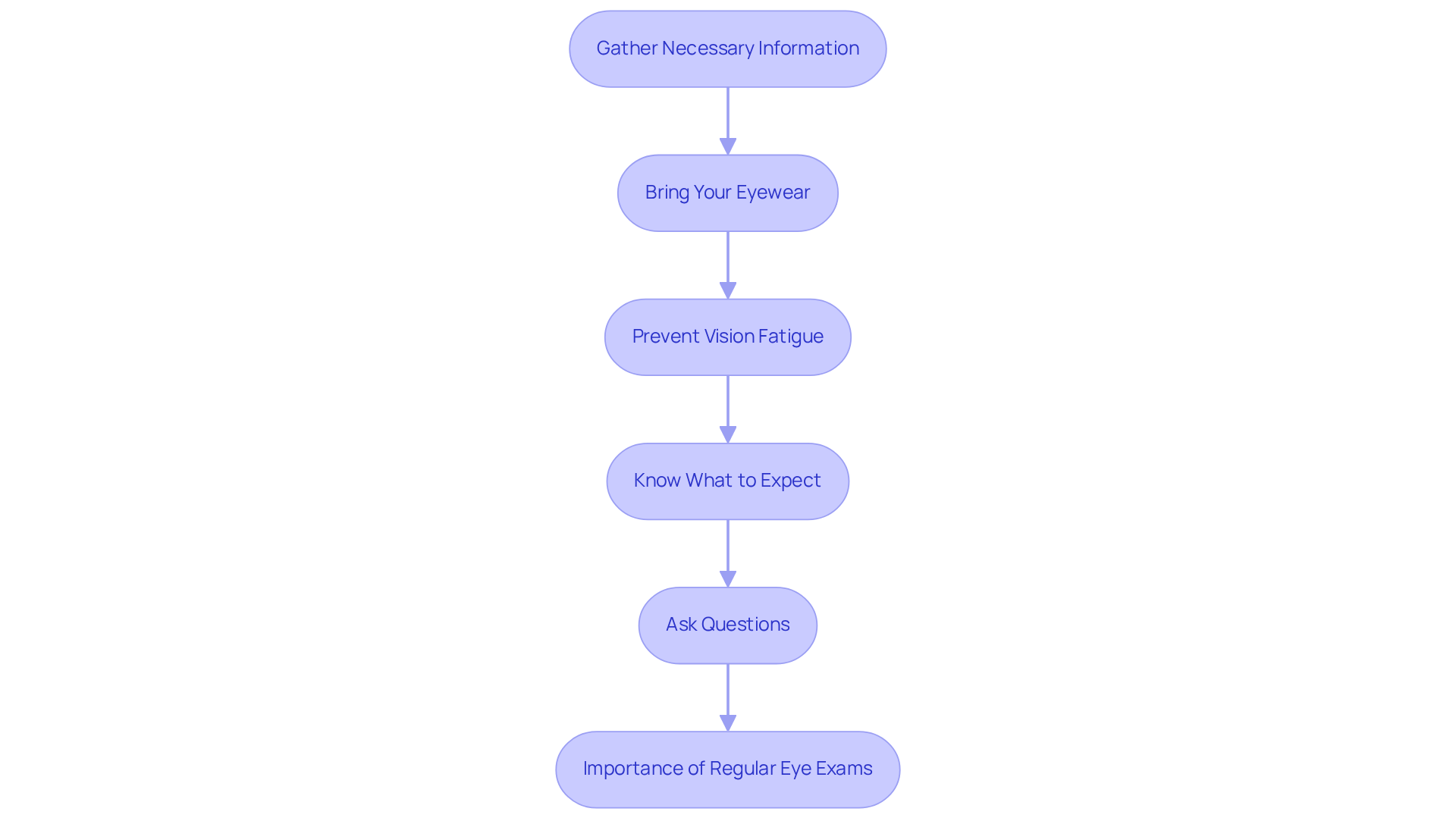Posted by: Northwest Eye in General on October 2, 2025
Overview
Having 20/40 vision isn’t necessarily classified as ‘bad,’ but it can present certain challenges in everyday life. You might find it difficult to recognize distant objects or read small print, which can be frustrating. We understand that adapting to this level of visual acuity can be a journey for many individuals.
While many people adjust well, it’s important to recognize that this vision level can impact activities like driving. You may find yourself needing corrective measures to enhance your visual experience.
Regular eye exams play a crucial role in monitoring your eye health and addressing any concerns you may have. We are here to help you through this process, ensuring you receive the care and support you need.
Introduction
Understanding visual acuity is essential for navigating the complexities of eye health, especially when grappling with the implications of 20/40 vision. We understand that this level of sight, while not classified as severely impaired, can significantly affect daily activities—from reading to driving.
It’s common to find yourself questioning whether 20/40 vision is truly bad, particularly as you encounter challenges that may hinder your quality of life.
What does this mean for those who live with it? How can you take proactive steps to ensure your vision remains as clear and functional as possible? We are here to help you through this process.
Understand Visual Acuity: What Does 20/40 Vision Mean?
Visual acuity measures how well you can see, typically expressed as a fraction. The initial number indicates the distance at which you can see an object clearly, while the subsequent number signifies the distance at which an individual with typical sight can see the same object. For instance, having 20/40 sight means you can see at 20 feet what someone with typical eyesight can see at 40 feet. This suggests that your sight is somewhat less clear than normal, which makes one wonder, is 20/40 vision bad, indicating mild visual impairment?
We understand that approximately 26.9 million adults in the U.S. experience low sight, leading many to wonder, is 20/40 vision bad? While some individuals adapt well to this level of acuity, many wonder if 20/40 vision is bad, as it’s common to feel challenged by daily tasks, such as reading small print or recognizing distant objects. Real-world examples illustrate this variability; for example, one patient enhanced their eyesight from 20/40 to 20/15 in just three months through targeted interventions.
Understanding this measurement is crucial for recognizing potential challenges in daily activities and determining whether corrective measures, such as glasses or contact lenses, are necessary to enhance visual clarity. Furthermore, blurred sight can be a sign of multiple eye issues, making it vital to consult an optometrist for routine eye examinations to monitor eye health and address any concerns.
At Northwest Eye, we are here to help you through this process. We provide extensive financing choices to assist you in covering eye exams, sight tests, and treatments for conditions such as cataracts. In many areas, individuals with 20/40 eyesight can legally drive, which raises the question of whether 20/40 vision is bad, although there may be restrictions. This highlights the practical implications of this level of visual acuity.
If you are experiencing blurred sight or other symptoms, seeking professional medical assistance is essential. Remember, you are not alone in this journey, and we are here to support you every step of the way.

Evaluate the Implications of 20/40 Vision on Daily Life
Individuals with 20/40 eyesight often face unique challenges in their everyday lives. We understand that recognizing street signs while driving or identifying faces from a distance can be notably more difficult. While many individuals with this level of visual acuity manage their daily tasks effectively, they may find themselves needing to be closer to objects for clearer visibility. Activities such as watching television or reading fine print can require additional effort. It’s common to consider corrective lenses, as they can significantly enhance clarity.
Statistics show that although it is not categorized as ‘bad,’ many wonder, is 20/40 vision bad compared to the standard 20/20 vision, and it can impact driving safety. In fact, most states allow individuals with 20/40 eyesight to drive without corrective eyewear. However, we recommend wearing prescription glasses for optimal safety.
Understanding these implications empowers individuals to make informed choices about their eye health and when to seek expert help. Remember, we are here to help you through this process.

Assess Your Vision: Steps to Determine the Need for Professional Evaluation
To evaluate your vision and determine if a professional assessment is necessary, we invite you to follow these steps:
-
Self-Assessment: Begin by evaluating your clarity of sight at various distances. It’s important to pay attention to any difficulties you may have in reading signs or seeing objects clearly from afar, particularly when considering if 20/40 vision is bad. Remember, age-related macular degeneration (AMD) affects approximately 11 million people in the U.S., highlighting the importance of regular self-assessment.
-
Utilize an Online Eye Exam: Consider reputable online eye assessments for a preliminary evaluation of your visual sharpness. While these tests can provide insight into whether your sight falls within normal ranges, it’s common to feel that they may be less accurate than in-person exams.
-
Monitor Symptoms: Keep a record of any symptoms you experience, such as frequent headaches, eye strain, sensitivity to light, or trouble focusing. These may suggest a need for expert evaluation. Symptoms like difficulty seeing at night can be particularly relevant for cataract patients. Understanding these symptoms is essential, as they may signal conditions treated at Northwest Eye, such as cataracts or diabetic retinopathy.
-
Schedule an Eye Exam: If you notice troubling symptoms or your self-evaluation indicates that your vision is 20/40 vision bad, we encourage you to set up an appointment with an eye care specialist at Northwest Eye for a thorough eye exam. Only a Northwest Eye professional can provide an accurate diagnosis. Routine examinations are essential, especially since many people neglect their eye health until problems arise. At Northwest Eye, our specialists are here to offer tailored care and explore innovative options such as the Light Adjustable Lens, ensuring you receive the best possible treatment for your eye requirements.

Prepare for Your Vision Test: What to Expect and How to Get Ready
Preparing for your vision test involves several essential steps to ensure a smooth and informative experience:
-
Gather Necessary Information: We understand that you may have concerns about your vision. Compile a list of any symptoms you’ve experienced, particularly those related to blurred sight, dry eyes, or macular degeneration, along with your medical history and current medications. This information is vital for your eye care specialist to evaluate your overall eye health effectively, especially since blurred vision can suggest conditions like cataracts or diabetic retinopathy, and it raises the question of whether is 20/40 vision bad.
-
Bring Your Eyewear: If you wear glasses or contact lenses, please remember to bring them to your appointment. This allows the eye care professional to evaluate your current prescription and make any necessary adjustments, helping you feel more comfortable during the exam.
-
Prevent Vision Fatigue: It’s common to feel anxious before an appointment. In the hours prior to your visit, try to avoid activities that may fatigue your vision, such as prolonged screen time or reading small text. This helps ensure your eyes are in optimal condition for testing, allowing for a more accurate assessment.
-
Know What to Expect: During the exam, you will undergo a series of tests designed to evaluate your visual acuity, eye health, and overall sight function. Familiarizing yourself with these procedures can help alleviate anxiety and make the experience more comfortable. Recognizing that unclear sight may indicate underlying problems can inspire you to participate fully in the process, particularly when you ask yourself, is 20/40 vision bad, knowing that you are taking an important step for your health.
-
Ask Questions: We encourage you to prepare a list of inquiries or concerns regarding your perspective or the exam process. Engaging with your eye care professional ensures you leave the appointment with a comprehensive understanding of your eye health and any necessary next steps.
Understanding these steps not only prepares you for your visit but also emphasizes the importance of regular eye exams, which are vital for maintaining good vision and detecting potential issues early. With nearly 900,000 Americans facing vision-damaging conditions like retinopathy and millions affected by glaucoma, proactive eye care is essential for preserving your sight. We are here to help you through this process.

Conclusion
Understanding the implications of 20/40 vision is crucial for navigating daily life and maintaining eye health. While this level of visual acuity is not classified as ‘bad,’ it can present challenges that affect everyday activities, such as driving, reading, and recognizing objects at a distance. We understand that recognizing these challenges can be daunting, but it empowers individuals to take proactive steps toward improving their vision and overall eye health.
This article delves into the nuances of 20/40 vision, outlining the importance of regular eye examinations and self-assessments. It’s essential to understand visual acuity, and there may be a potential need for corrective measures. Preparing for a vision test is a vital step in this journey. By consulting eye care professionals and monitoring symptoms, individuals can ensure they receive appropriate care and treatment for any underlying conditions.
Ultimately, prioritizing eye health is essential for preserving vision and enhancing quality of life. Taking the time to assess your vision, seek professional evaluation, and understand the implications of visual acuity can lead to informed decisions that safeguard your sight. Embracing these proactive measures can make a significant difference in managing the effects of 20/40 vision and ensuring a clearer, more vibrant view of the world. We are here to help you through this process, and together, we can navigate the path to better eye health.
Frequently Asked Questions
What does 20/40 vision mean?
20/40 vision means you can see at 20 feet what someone with typical eyesight can see at 40 feet, indicating that your sight is somewhat less clear than normal.
Is 20/40 vision considered bad?
While some individuals adapt well to 20/40 vision, it can indicate mild visual impairment, making daily tasks like reading small print or recognizing distant objects more challenging.
How common is low vision among adults in the U.S.?
Approximately 26.9 million adults in the U.S. experience low vision.
Can vision improve from 20/40 to a better level?
Yes, there are real-world examples where individuals have improved their eyesight from 20/40 to 20/15 through targeted interventions.
What should someone with 20/40 vision consider regarding corrective measures?
Individuals with 20/40 vision should consider whether corrective measures, such as glasses or contact lenses, are necessary to enhance visual clarity.
What are some potential causes of blurred sight?
Blurred sight can be a sign of multiple eye issues, which is why it’s important to consult an optometrist for routine eye examinations.
Can individuals with 20/40 vision legally drive?
In many areas, individuals with 20/40 vision can legally drive, although there may be restrictions based on local laws.
What should I do if I’m experiencing blurred sight?
If you are experiencing blurred sight or other symptoms, seeking professional medical assistance is essential.






